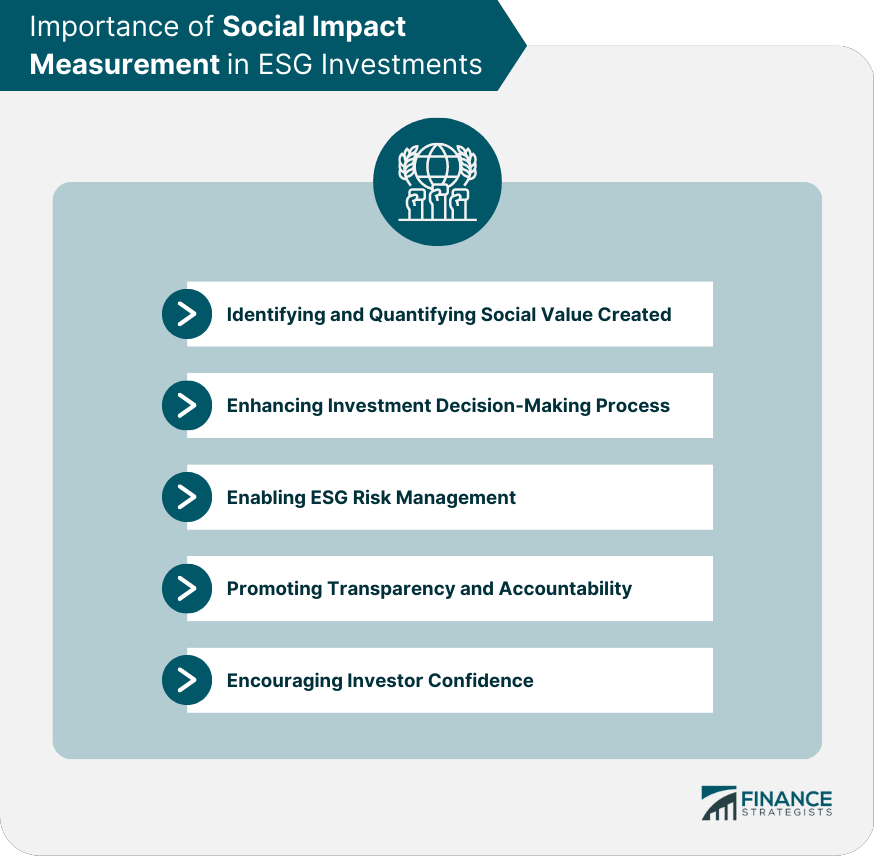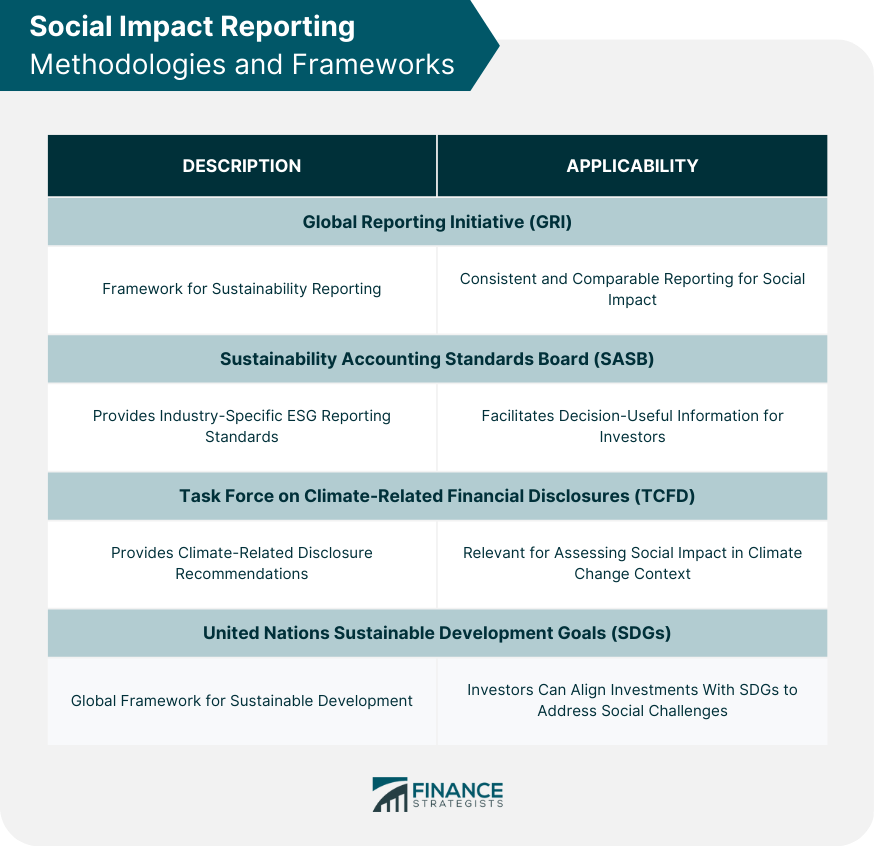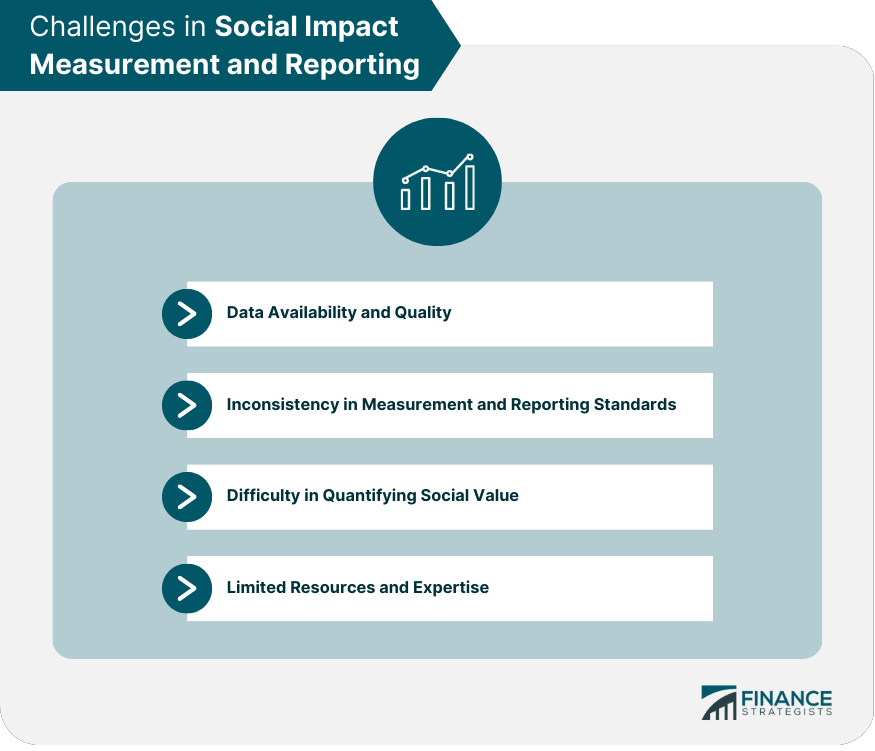Social impact measurement and reporting is the process of evaluating and communicating the social and environmental impact of a company's activities. It involves collecting data and information on a range of factors, such as carbon emissions, employee diversity, community involvement, and supply chain sustainability, to name a few. The collected data is then analyzed and reported in a standardized format to help stakeholders, including investors, assess a company's overall impact. In the context of environmental, social, and governance (ESG) investments, social impact measurement and reporting is essential as it enables investors to identify companies that align with their values and investment goals. ESG investors seek to invest in companies that demonstrate strong social and environmental performance, and social impact measurement and reporting provide a reliable and standardized way to assess a company's performance in these areas. Social impact measurement helps investors identify and quantify the social value created by their investments. By assessing the positive and negative effects of investments on society, investors can better understand the true impact of their investment decisions and prioritize investments that create sustainable value. Social impact measurement provides valuable insights that can inform and enhance the investment decision-making process. By incorporating social performance metrics alongside financial data, investors can make more informed decisions that align with their ESG goals and values. Measuring and reporting social impact enables investors to identify and manage ESG risks more effectively. By understanding the social implications of their investments, investors can mitigate potential risks and enhance the resilience and sustainability of their investment portfolios. Social impact reporting promotes transparency and accountability by disclosing the social performance of investments to stakeholders. This transparency helps build trust among investors, companies, and the broader public, fostering a more responsible investment landscape. As more investors seek to incorporate ESG factors into their investment strategies, social impact measurement and reporting can help instill confidence in the social performance of investments. This confidence, in turn, can lead to increased capital flows into ESG investments. A critical first step in social impact measurement is establishing clear objectives and KPIs. These objectives should align with the investor's ESG goals and provide a framework for measuring and evaluating the social performance of investments. Surveys and interviews are common methods for collecting quantitative and qualitative data on the social impact of investments. These methods can provide valuable insights into stakeholder perspectives and experiences. Monitoring and evaluation systems are essential tools for tracking social performance over time. These systems help investors identify trends, assess progress toward objectives, and make data-driven decisions. SROI analysis is a popular method for quantifying social value created by investments. By comparing the social benefits generated to the investment costs, SROI can help investors evaluate the efficiency and effectiveness of their investments. The GRI is a widely recognized framework for sustainability reporting that covers a range of environmental, social, and governance issues. Investors can use GRI guidelines to report on the social impact of their investments in a consistent and comparable manner. The SASB provides industry-specific standards for ESG reporting that can help investors disclose material social performance information. These standards facilitate comparability and decision-useful information for investors. While the TCFD primarily focuses on climate-related disclosures, its recommendations can also inform social impact reporting, particularly in relation to climate-related risks and opportunities that affect social outcomes. The SDGs provide a global framework for sustainable development that can be used as a reference for measuring and reporting on social impact. By aligning their investments with the SDGs, investors can demonstrate their commitment to addressing global social challenges. One of the main challenges in social impact measurement and reporting is the availability and quality of data. Collecting accurate, reliable, and timely data on social performance can be resource-intensive and complex, particularly for smaller investors and companies. Inconsistency in measurement and reporting standards can make it difficult for investors to compare social performance across investments. The lack of universally accepted standards and methodologies can lead to confusion and limit the usefulness of social impact reporting. Quantifying social value can be challenging due to the inherently qualitative nature of many social outcomes. This can make it difficult for investors to assess the social performance of their investments in a consistent and comparable manner. Many investors and companies may lack the resources and expertise needed to effectively measure and report on social impact. This can lead to underreporting or inadequate measurement of social performance, limiting the effectiveness of ESG investment strategies. Investors should develop a robust measurement strategy that includes clear objectives, KPIs, and methodologies for data collection and analysis. This strategy should be tailored to the investor's specific ESG goals and investment context. Investors can leverage technology and data analytics tools to improve the efficiency and accuracy of social impact measurement and reporting. Advanced data analysis techniques, such as machine learning and artificial intelligence, can help investors derive actionable insights from large datasets. Investors should align their social impact measurement and reporting practices with international standards and frameworks, such as the GRI, SASB, TCFD, and SDGs. This alignment can enhance the credibility and comparability of social performance disclosures. Involving stakeholders, such as beneficiaries, employees, and community members, in the social impact measurement and reporting process can provide valuable insights and help ensure that the reported information is relevant and accurate. Investors should regularly review and update their social impact measurement and reporting methodologies to reflect evolving best practices, stakeholder expectations, and regulatory requirements. Social impact measurement and reporting play a critical role in ESG investments, enabling investors to assess the social performance of their investments and make more informed decisions that align with their ESG goals and values. Despite the challenges associated with data availability, inconsistency in standards, and quantifying social value, implementing best practices and leveraging technology can enhance the effectiveness of social impact measurement and reporting. As ESG investing continues to gain momentum, the importance of social impact measurement and reporting is likely to grow, driving further innovation, standardization, and collaboration among investors, companies, and other stakeholders. By prioritizing social impact measurement and reporting, investors can contribute to a more sustainable and equitable future for all.What Is Social Impact Measurement and Reporting?
Importance of Social Impact Measurement in ESG Investments
Identifying and Quantifying Social Value Created
Enhancing Investment Decision-Making Process
Enabling ESG Risk Management
Promoting Transparency and Accountability
Encouraging Investor Confidence

Key Components of Social Impact Measurement and Reporting
Establishing Objectives and Key Performance Indicators (KPIs)
Data Collection and Analysis
Surveys and Interviews
Monitoring and Evaluation Systems
Social Return on Investment (SROI) Analysis
Reporting Methodologies and Frameworks
Global Reporting Initiative (GRI)
Sustainability Accounting Standards Board (SASB)
Task Force on Climate-Related Financial Disclosures (TCFD)
United Nations Sustainable Development Goals (SDGs)

Challenges in Social Impact Measurement and Reporting
Data Availability and Quality
Inconsistency in Measurement and Reporting Standards
Difficulty in Quantifying Social Value
Limited Resources and Expertise

Best Practices for Social Impact Measurement and Reporting
Developing a Robust Measurement Strategy
Leveraging Technology and Data Analytics
Aligning With International Standards and Frameworks
Engaging Stakeholders Throughout the Process
Regularly Reviewing and Updating Measurement and Reporting Methodologies
Conclusion
Social Impact Measurement and Reporting FAQs
Social impact measurement and reporting is the process of evaluating and communicating the social and environmental impact of a company's activities. It is essential for ESG investments as it helps investors identify companies that align with their values and investment goals.
Some commonly used frameworks and methodologies for social impact measurement in ESG investments include the Global Reporting Initiative (GRI), the Sustainability Accounting Standards Board (SASB), and the Impact Reporting and Investment Standards (IRIS).
Social impact reporting provides investors with reliable data and information on a company's social and environmental impact. This information helps investors make informed decisions and select companies that align with their investment goals and values.
Companies can improve their social impact measurement and reporting practices by adopting standardized frameworks and methodologies, providing clear and concise information, and ensuring transparency and accuracy in their reporting.
Companies such as Patagonia and Ben & Jerry's have successfully incorporated social impact measurement and reporting into their business practices. Their efforts have influenced investment decisions by attracting socially conscious investors who seek to support companies that align with their values.
True Tamplin is a published author, public speaker, CEO of UpDigital, and founder of Finance Strategists.
True is a Certified Educator in Personal Finance (CEPF®), author of The Handy Financial Ratios Guide, a member of the Society for Advancing Business Editing and Writing, contributes to his financial education site, Finance Strategists, and has spoken to various financial communities such as the CFA Institute, as well as university students like his Alma mater, Biola University, where he received a bachelor of science in business and data analytics.
To learn more about True, visit his personal website or view his author profiles on Amazon, Nasdaq and Forbes.















